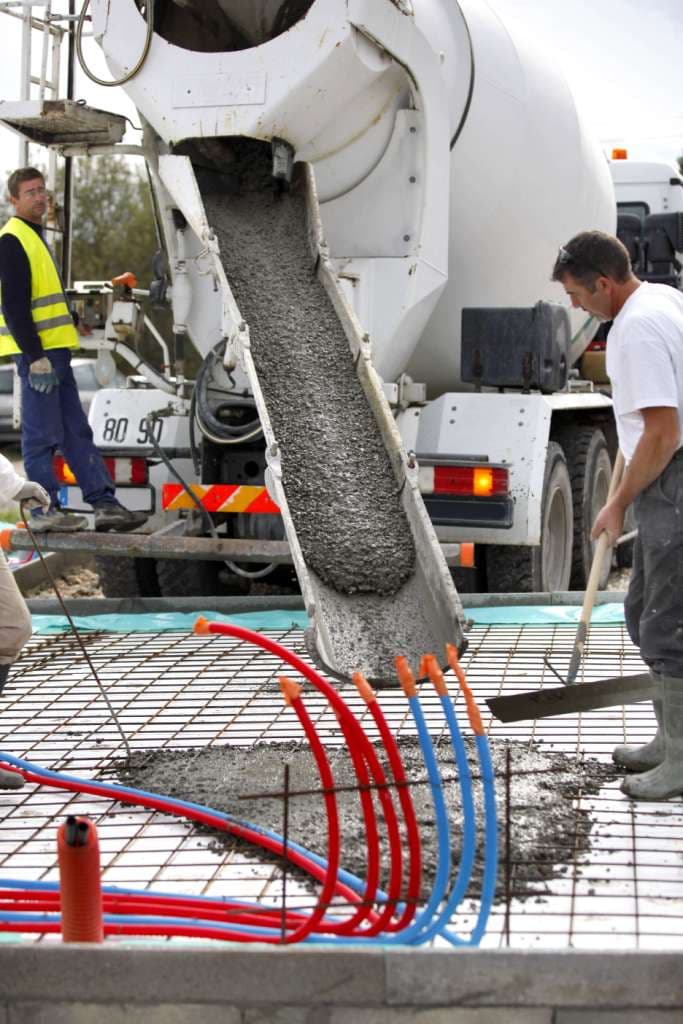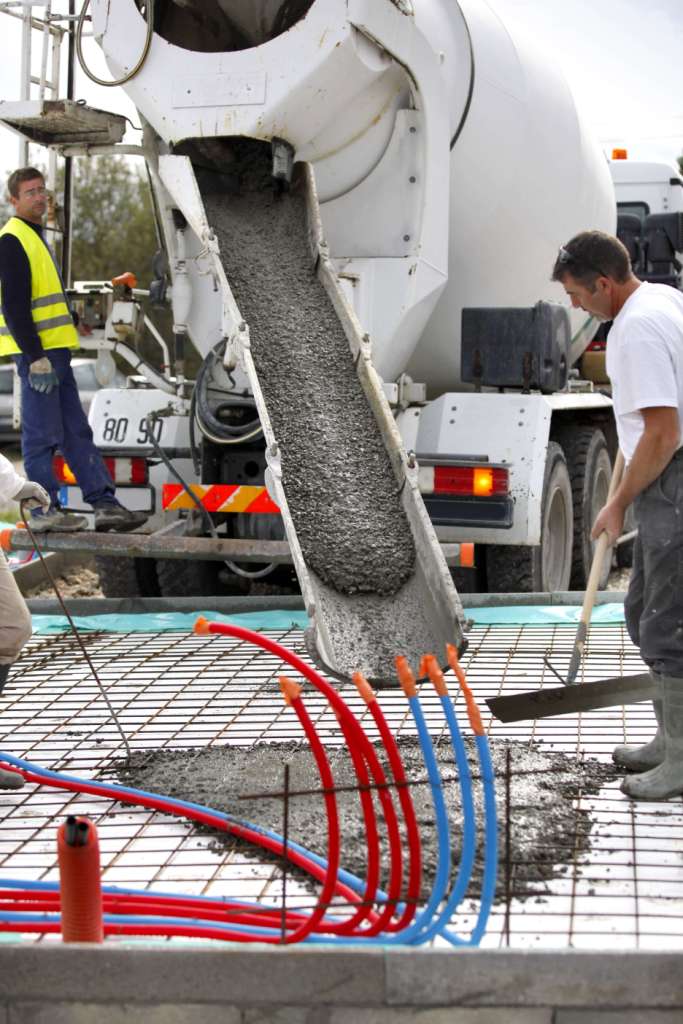
Ready mix concrete is a concrete which is mixed in the stationary mixture in the central batching and mixing plant. It is delivered in fresh condition to the purchaser at the site. It is supplied in the truck, in which, the mixture is mounted on the self–propelled chassis, capable of mixing the ingredients of concrete during the transportation. In simple word, ready mix concrete is transported in the specially designed truck called as a transit mixer, in which, the concrete is kept under continuous rotation until it is taken out for use .i.e. placed.

The ready mix concrete is a great solution against the ordinary concrete mix as it require less labour, time, efforts and has lesser cost. It is also a distinctive material as it helps to maintain uniform quality throughout the work and gives you the high speed of concrete construction. Ready mix concrete helps to avoid the problems like poor workability, segregation, and bleeding, improper water cement ratio, inadequate mixing time which are always faced in the traditional concrete mixes.
Also Read:
Workability of concrete
Segregation in Concrete
Bleeding in Concrete
Most producers provide the ready mix concrete at site. You can find the list of local ready mix concrete dealers from the internet or yellow pages. It is necessary to contact RMC dealer or producer to decide the terms and conditions of supply and payment before you order the concrete mix.
Before you order ready mix concrete, you have to provide basic necessary information to the producer as follows.
01. Grade of Concrete or Mix Design
- Types of work where you are planning to pour concrete i.e. foundation slab, floor slab,pavements, etc.
- Grade of concrete you require on site, i.e. M15, M20, M25, M30, etc.
- Slump of concrete both at the batching plant and at the site.
- The quantity of concrete in cubic meter or cubic yard.
- Address or place of concrete pouring.
- Time of requirement of ready mix concrete on site.
- Time of interval between the two consecutive deliveries of RMC (in the case of larger quantity i.e. greater than 6 cubic meter).
02. Be Aware of Excessive Use of Fly Ash
It is necessary to know the proportion of fly ash in the concrete. Some RMC producer adds very high amount of fly ash in concrete which aren’t recommended also by the standards. Normally the fly ash is added in concrete at levels ranging from 15% to 25% by mass of the cementitious material component. Plant owner do this to reduce their cost and increase profits. Hence, buyer has to aware before buying RMC at lower rates, and should not get cheated by this lower rates.
It is also necessary to know the source of each concrete ingredients (cement, aggregates, admixture, and water), the proportion and quantity of the concrete ingredient per cubic meter, and the types of admixtures used in RMC. Hence, before you order ready mix concrete, ask a dealer for the above information. i.e. details of mix design.
03. Source of Ingredients
The RMC dealers purchase different concrete ingredients from the different sources. Some sources provide good quality materials or some may not. You have to evaluate the dealer by judging their sources. If their sources are well-known in the local market for the quality, then you can choose the ready-mix dealer, who buys the concrete ingredients from those reputed sources.
04. Time for Transportation
As per IS 4926:2003, it is advisable to pour the ready mix concrete within 2 hours from the time of loading at the central batching plant. However, a longer period may be permitted if retarding admixture is used. But, ascertain which is the retarder used, and are all steps followed as recommended by retarding manufacture.
05. Use of Admixture
Sometimes the additional dose of admixture may be added at the project site to regain the workability of concrete. Some admixtures contain chlorides, and if so, it is necessary to know the amount of chloride content in percentage of the total mass of admixture. If the amount of chloride is high in ready mix concrete, it will result into corrosion of the reinforcement steel which affects the service life of the house or building. Hence, such admixtures should be avoided. Normally, nowadays no one uses chloride-based admixtures.
06. Test of Concrete
It is specified in standards that the ready mix concrete dealers shall have test facilities at its premises to carry out routine tests, i.e. concrete slump test, concrete cube testing, etc. Hence, you can cross check the workability and strength of ordered concrete.
You can check the workability of concrete by carrying out slump test on site. Slump of concrete mostly depends on the condition of placing and the requirement of degree of workability. As per IS 456:2000, low reinforced sections like slabs, beams, walls, columns, etc. are casted with the slump of 25 to 75 mm. Heavily reinforced sections like slabs, beams, walls, columns, etc. are casted with the slump of 50 to 100 mm. In the case of slip form work or pumped concrete, the suitable slump of concrete is 75 to 100mm.
07. Traffic Problem
In a bid to reduce traffic snarls and accidents on roads, some city police have framed new rules to unclog the main roads by restricting the movement of heavy and goods vehicles during peak hours. Hence, if you live in this kind of city, then it is necessary to plan pouring of concrete according to suchtraffic rules and time.
08. Information about Delivery Ticket of Ready Mix Concrete
Following information should be included in the ready mix concrete delivery ticket for each batch:
- Name and number of the ready-mixed concrete plant.
- Date and serial number of the ticket
- Truck Number
- Name of the purchaser and location of the site
- Grade of concrete
- Mix design details
- Type and size of concrete ingredients and their weight in table format.
- The quantity of concrete in the cubic meter
- Time of loading
- Slump results at the batching plant
- Signature of the concrete plant operator
Following information are needed to be filled on ready mix concrete ticket on site.
- Time of arrival on site
- The time when discharge was completed
- Any water/admixture added on site
- Location of pouring of concrete
- Slump test result at the site
- Signature of RMC receiver
The popularity of concrete is increasing day by day but it also carries with it a great environmental cost. Natural materials are mined and processed every day. It leaves a mark that we make the environment unhealthy. But by identifying and exploring the various properties of waste materials or byproduct like fly ash, it became possible to add value to the ready mix concrete. It indicates that we are now aware of the effect of an unhealthy environment and we are now moving toward the use of green materials which helps to make green buildings.
Must Read:
Do’s & Don’ts While Concreting
What is Concrete Mix Design (CMD)?






























